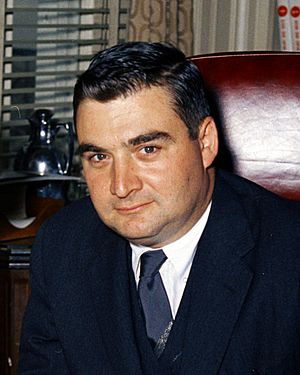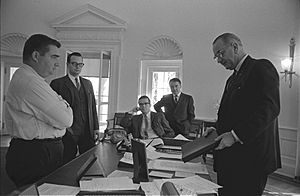Pierre Salinger facts for kids
Quick facts for kids
Pierre Salinger
|
|
|---|---|

Salinger in 1961
|
|
| United States Senator from California |
|
| In office August 4, 1964 – December 31, 1964 |
|
| Appointed by | Pat Brown |
| Preceded by | Clair Engle |
| Succeeded by | George Murphy |
| 9th White House Press Secretary | |
| In office January 20, 1961 – March 19, 1964 |
|
| President | John F. Kennedy Lyndon B. Johnson |
| Preceded by | James Hagerty |
| Succeeded by | George Reedy |
| Personal details | |
| Born |
Pierre Emil George Salinger
June 14, 1925 San Francisco, California, US |
| Died | October 16, 2004 (aged 79) Cavaillon, France |
| Resting place | Arlington National Cemetery |
| Political party | Democratic |
| Spouses |
Renée Labouré
(m. 1947; div. 1957)Nancy Joy
(m. 1957; div. 1965)Nicole Gillman
(m. 1965; div. 1989)Nicole de Menthon
(m. 1989) |
| Education | San Francisco State University University of San Francisco (BS) |
| Military service | |
| Allegiance | |
| Branch/service | |
| Battles/wars | World War II |
Pierre Emil George Salinger (June 14, 1925 – October 16, 2004) was an American journalist, writer, and politician. He is best known for serving as the ninth press secretary for United States Presidents John F. Kennedy and Lyndon B. Johnson. Salinger also served as a U.S. Senator in 1964. Later, he became a well-known correspondent for ABC News.
Contents
Early Life and Musical Talent
Pierre Salinger was born in San Francisco, California. His mother was French, and his father was from New York City. Pierre was a very talented musician from a young age. He played the piano even before he learned to read.
When his family moved to Canada, his parents saw his amazing piano skills. They enrolled him in the Toronto Conservatory of Music. He practiced piano for many hours each day. He gave his first public concert when he was six years old.
When Pierre was 12, his mother suggested he take a break from piano. She wanted him to try other activities and meet more people. He did, and he never went back to being a full-time pianist. Instead, he decided he wanted to be a writer or journalist.
His love for music stayed with him. When he was press secretary, he invited famous musicians like Pablo Casals to the White House. President Lyndon B. Johnson even asked Salinger to play the piano for his guests once.
Education and Military Service
Salinger went to Lowell High School in San Francisco. He then attended San Francisco State University from 1941 to 1943. While there, he became the managing editor of the student newspaper.
In July 1943, Salinger joined the United States Navy during World War II. He was the skipper of a submarine chaser near Okinawa. He was recognized for bravely rescuing men during a typhoon. For this, he received the Navy and Marine Corps medal. After the war, he finished his studies at the University of San Francisco, earning a degree in 1947.
He started his journalism career as a reporter for the San Francisco Chronicle.
Working with President Kennedy
In 1956, Pierre Salinger wrote articles about a labor union leader named Jimmy Hoffa. Because of this work, Robert F. Kennedy hired him. Salinger became a legal counsel for a Senate committee investigating organized crime. Later, Robert Kennedy asked him to be the press secretary for his brother, John F. Kennedy, who was a Senator at the time.
Salinger worked on John Kennedy's presidential campaign in 1960. He became an important part of the campaign team. After Kennedy was elected president in 1961, he chose Salinger as his press secretary. Salinger was known for managing the press with humor and energy. He became quite famous himself.
President Kennedy was the first president to allow live television broadcasts of his news conferences. Salinger helped manage these events. He traveled with President Kennedy to meetings with other world leaders. This included a meeting with Soviet Premier Nikita Khrushchev in Vienna in 1961.
Meeting Khrushchev
In May 1962, Salinger went to Moscow alone to meet with the press. While there, he was surprisingly invited to spend time with Khrushchev at his country home. They shared meals and talked about politics and world events for many hours. Khrushchev even said he had such a good time that he wanted to do it again the next day.
In October 1962, Salinger told the press about Soviet missiles being placed in Cuba. This event was known as the Cuban Missile Crisis. He later said that President Kennedy's actions during this crisis were incredible. He noted how close the countries came to a nuclear war.

When President Kennedy was assassinated in November 1963, Salinger was on a plane to Tokyo. He was going to attend an economic conference. Salinger stayed on as press secretary for the new President, Lyndon B. Johnson. Johnson said he didn't know what he would have done without Salinger during that difficult time. In 1966, Salinger published a book about President Kennedy called With Kennedy.
Running for Senate
After working for Presidents Kennedy and Johnson, Salinger moved back to California. He decided to run for the U.S. Senate. He won the Democratic primary election. The Governor of California, Pat Brown, then appointed Salinger to fill a Senate vacancy. Salinger took office on August 4, 1964.
However, in the election for a full six-year term, Salinger lost to former actor George Murphy. One reason for his loss was that he had only recently returned to California. His legal residency was even challenged. He also strongly supported a law to ban racial housing discrimination, which some people did not like. Salinger's loss was a surprise because it was a very good year for Democrats in other Senate races.
Salinger left the Senate on December 31, 1964. He then worked in the private business world, including as a vice president for Continental Airlines.
Television Appearance
Salinger appeared in an episode of the ABC Television series Batman on January 4, 1968. He played a lawyer named "Lucky Pierre" who defended Catwoman and the Joker in a trial.
Robert Kennedy's Campaign
Pierre Salinger was one of the managers for United States Senator Robert F. Kennedy's presidential campaign in 1968. Salinger was close by when Robert Kennedy was assassinated in Los Angeles on June 6, 1968. Salinger was deeply saddened by this event. After the assassination, he moved to France and became a correspondent for a news magazine called L'Express.
Journalism for ABC News
In 1976, ABC Sports hired Salinger as a commentator for the Olympic Winter Games. In 1978, he joined ABC News as its Paris bureau chief. He later became the network's chief European correspondent in London in 1983.
In 1981, Salinger received an award for his reporting. He revealed that the U.S. government was secretly negotiating to free Americans held hostage by Iran.
In November 1989, Salinger reported for ABC's Prime Time Live. He claimed that Iran had paid others to carry out the Pan Am Flight 103 bombing.
After Iraq invaded Kuwait in August 1990, ABC sent Salinger to the Middle East. He got a copy of a conversation between Saddam Hussein and the U.S. Ambassador to Iraq. In the conversation, the ambassador told Saddam, "We have no opinion on your Arab-Arab conflicts." Some people thought this statement encouraged Saddam to invade Kuwait.
Claims About TWA Flight 800
Three months after TWA Flight 800 exploded, Salinger claimed he had a document proving a conspiracy theory. He said the plane was shot down by "friendly fire" (meaning by accident from U.S. forces). He also claimed the U.S. government covered it up. Salinger said an intelligence agent sent him the document.
However, what Salinger was promoting was actually a hoax document. It had been circulating on the internet for weeks before he received it. By sharing this information, Salinger helped make these conspiracy theories more widely believed.
Because of this event, the term "Pierre Salinger Syndrome" was created. This term describes someone who believes everything they read on the internet is true.
Later Life and Death
After leaving ABC, Salinger moved back to Washington. He worked for a public relations firm.
In November 2000, he was frustrated when he was not allowed to present evidence during a trial. The trial was for two Libyans accused of bombing Pan Am 103 over Lockerbie, Scotland. Salinger stated he knew who the real bombers were. However, the judge told him he could not share that information in court.
Pierre Salinger died from heart failure on October 16, 2004, at the age of 79. He passed away at a hospital in Cavaillon, France, near his home. He is buried in Arlington National Cemetery in the United States.
|

